Where is Piazza Colonna and what is Marcus Aurelius’ Column
Piazza Colonna in Rome and the Aurelian Column: what is it and how the Propaganda of Roman Monument Meant to Shape Public Perception
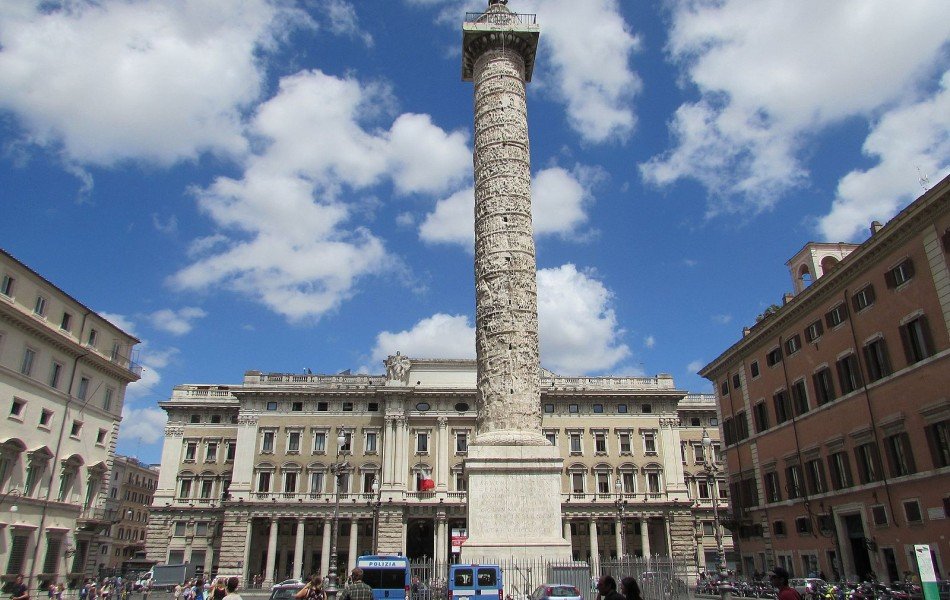
20 February 2025
Rome Travel GuideA Square Built Around a Column
Piazza Colonna, located in the very heart of Rome, is not just an urban space; it is a historical crossroads where ancient imperial grandeur meets modern political life. The square takes its name from its most prominent feature: the Column of Marcus Aurelius, a towering monument dedicated to one of Rome’s most revered emperors. Unlike many of Rome’s other grand piazzas, which were planned as open spaces with fountains, statues, or churches, Piazza Colonna developed organically around this singular structure, which has dominated the site for nearly two millennia.
Unlike its more famous counterpart, Trajan’s Column, the Column of Marcus Aurelius is less studied by the casual visitor, yet it is no less significant. It stands not just as a work of architectural mastery but as a historical document in stone, narrating the dramatic and brutal military campaigns of Marcus Aurelius. The column serves as both a propaganda tool and an artistic masterpiece, designed to immortalize the emperor’s victories and reinforce the authority of Rome’s rulers.
Just steps from Piazza Colonna, hidden beneath Rome’s streets, lies an ancient world, you can discover it passing by Piazza Colonna in on our Trevi Fountain Underground Tour.
Where Is Piazza Colonna and Why Is It Important?
Piazza Colonna is centrally located along Via del Corso, one of Rome’s most important thoroughfares, a street that has served as a political and commercial artery since antiquity. Today, the square is surrounded by buildings of immense political importance, most notably Palazzo Chigi, the official residence of Italy’s Prime Minister, and Palazzo Wedekind, which houses the editorial offices of the newspaper Il Tempo. These buildings, despite being built centuries after the Roman Empire, reinforce the idea that Piazza Colonna has always been a center of power, where leaders shape the fate of the nation.
The presence of the column, however, anchors the space in antiquity. Standing 39 meters (128 feet) high, it dominates the square, an ever-present reminder of Rome’s imperial past. As tourists and government officials move through the square, they unknowingly walk through what was once the Campus Martius, an open field used for military exercises, religious ceremonies, and monumental constructions in ancient times. The column is a relic of this era, a vestige of when emperors celebrated their conquests through architectural splendor rather than political speeches or televised broadcasts.
Who Built the Column of Marcus Aurelius?
The Column of Marcus Aurelius dominates Piazza Colonna, a striking reminder of Rome’s imperial past and one of the best-preserved monuments of its kind. Rising to 39 meters (128 feet), it was inspired by Trajan’s Column but differs in both style and tone, reflecting the shifting artistic and political climate of the late 2nd century AD. While Trajan’s column presents a detailed and orderly record of his Dacian Wars, the reliefs on Marcus Aurelius’s column are bolder, deeper, and more dramatic, emphasizing divine intervention, raw emotion, and the harsh realities of war.
The spiraling high-relief frieze, which wraps around the column 21 times, tells the story of the emperor’s campaigns against the Germanic tribes and Sarmatians along the Danube frontier (172–175 AD). Scenes of battles, negotiations, religious rituals, and acts of mercy unfold in a continuous narrative, creating a visual epic of Rome’s struggle to defend its borders. Unlike earlier works, the figures are carved in higher relief, with exaggerated facial expressions and dynamic movement, making them easier to see from below. This stylistic shift reflects the growing sense of urgency and instability in the later Roman Empire, where military victories were no longer mere conquests but desperate defenses of Rome’s supremacy.
Despite the alterations, the Column of Marcus Aurelius remains a monument of power, resilience, and propaganda, capturing the defining struggles of an emperor who spent much of his reign at war. The stories carved into its surface still speak across the centuries, preserving a moment when Rome, though embattled, was still the unchallenged ruler of the known world.
A Chronicle in Stone: The Carvings of the Column
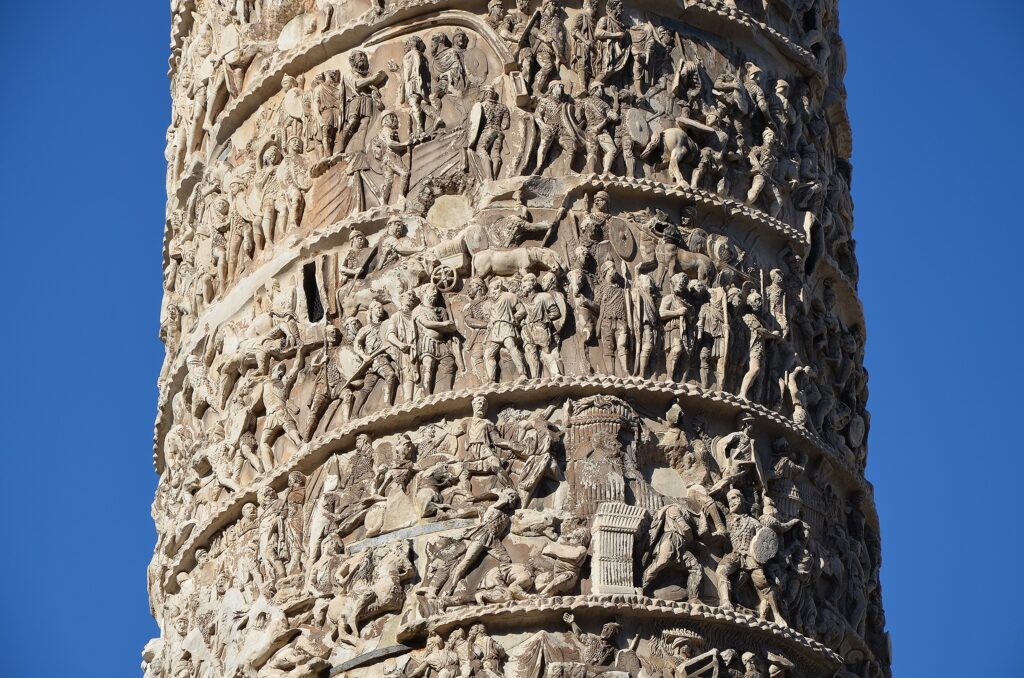
The frieze is a remarkable artistic achievement, showcasing battle scenes, religious ceremonies, acts of diplomacy, and moments of imperial leadership. Every figure and detail is meticulously carved, reflecting the craftsmanship and skill of the Roman sculptors. The high relief technique, where figures are deeply cut into the stone, creates a striking effect, making the figures more pronounced and easier to see from below. This stylistic choice is noticeably bolder and more dramatic than that of Trajan’s Column, which was built earlier in 113 AD and features more delicate, orderly carvings. The deeper reliefs on the Column of Marcus Aurelius were likely intended to improve visibility from a distance, allowing viewers standing in the square to perceive the narrative more clearly.
The scenes depicted on the column are not simply random moments of war; they follow a carefully structured sequence that glorifies the emperor’s role as both a military commander and a just ruler. The emperor is repeatedly shown leading his troops, offering prayers to the gods, delivering speeches, and personally overseeing battles. These visual cues reinforce the message that Marcus Aurelius was not only a skilled general but also a ruler guided by divine favor and wisdom.
The Miraculous Rain Scene: Divine Favor in Battle
Among the hundreds of individual carvings that make up the column, one of the most striking is the Miraculous Rain Scene, a moment of divine intervention that allegedly saved the Roman army. According to historical sources, during one of Marcus Aurelius’s campaigns against the Quadi, a Germanic tribe, the Roman army found itself trapped and near defeat, suffering from intense heat and dehydration. Suddenly, a powerful storm erupted, quenching the soldiers' thirst and reinvigorating their strength, while lightning and hail struck the enemy forces, scattering them in terror.
On the column, this miraculous event is depicted in dramatic fashion: a massive, bearded god-like figure, possibly Jupiter Pluvius (Jupiter the Rain-Bringer) or a personification of the rain itself, stretches his arms out as water cascades from his fingertips. Below him, Roman soldiers lift their shields to catch the falling rain, drinking deeply, while their enemies collapse under the wrath of the storm. This depiction not only reinforces the idea that Marcus Aurelius was favored by the gods but also serves as imperial propaganda, demonstrating that nature itself intervened to ensure Rome’s victory.
Later Christian writers reinterpreted this event, attributing the storm’s divine intervention to the prayers of Christian soldiers in the Roman army. This Christian version of the story was particularly useful in the Middle Ages, when efforts were made to depict Marcus Aurelius as a proto-Christian figure, though in reality, he remained a firm adherent of traditional Roman religious practices.
The Column’s Transformation Over Time
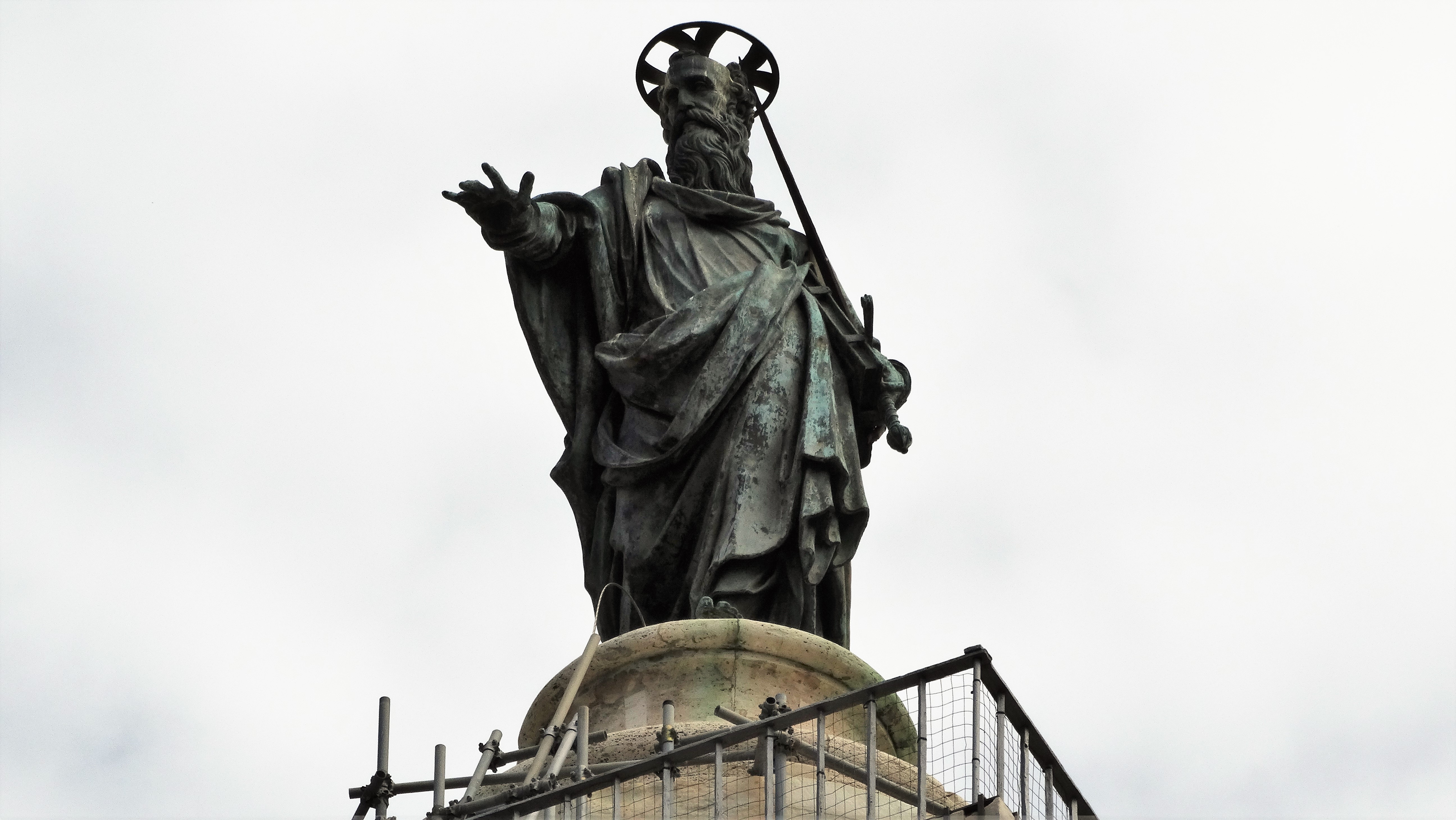
Like many of Rome’s ancient monuments, the Column of Marcus Aurelius underwent significant changes in later centuries. Originally, the column was crowned by a bronze statue of Marcus Aurelius, placed atop the monument to emphasize his divine status and eternal presence. This statue, now lost, likely depicted the emperor in a pose similar to that of the Colossus of Constantine or the Equestrian Statue of Marcus Aurelius, which still stands on Rome’s Capitoline Hill today. The placement of the statue would have required viewers to look up toward the sky to see the deified emperor, reinforcing the notion of his ascension to the heavens after death.
However, the column’s original purpose and imperial message were altered in the late 16th century. Under Pope Sixtus V, a fervent reformer who sought to Christianize many of Rome’s ancient monuments, the bronze statue of Marcus Aurelius was removed and replaced with a statue of Saint Paul in 1589. This change was part of a broader effort by the Catholic Church to redefine the city’s pagan past in a Christian context. Similar modifications were made to Trajan’s Column, which was topped with a statue of Saint Peter, as well as to various Roman obelisks that were fitted with crosses or other Christian symbols.
For Pope Sixtus V, this was not merely an aesthetic change but a spiritual and ideological transformation. By replacing Marcus Aurelius with Saint Paul, the column’s symbolism shifted from imperial triumph to Christian moral authority. It became a monument of faith rather than a testament to military conquest. Despite this change, the original friezes remained untouched, allowing modern scholars and visitors to still read the fascinating story carved into its surface.
Piazza Colonna, with its towering column, remains one of the most historically rich spaces in Rome. While modern visitors might focus on the surrounding government buildings or the bustling shopping arcades nearby, the real soul of the square lies in its ancient heart—the column that tells the story of an emperor, a war, and an empire struggling to maintain its borders. If you want to know more about iconic monuments in Rome such as the Pantheon or Trevi Fountain take a look also at our article on what to see in the historic center!
Our categories:
You may also be interested ...
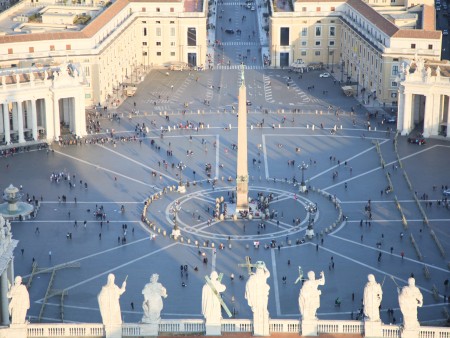
Vatican Private Tour with Sistine Chapel & St. Peter's Basilica: Renaissance’s Wonders
Private tour
Discover with a skip the line Private Vatican Tour the Sistine Chapel, Vatican Museums and St Peter’s Basilica
starting from: € 275
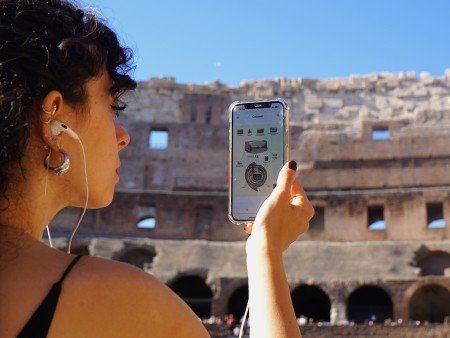
Colosseum Guided Audio Tour with Roman Forum and Palatine Hill
Private tour
Discover Ancient Rome’s secrets and history with our immersive Colosseum guided audio tour, rich in image and content
starting from: € 51 € 42